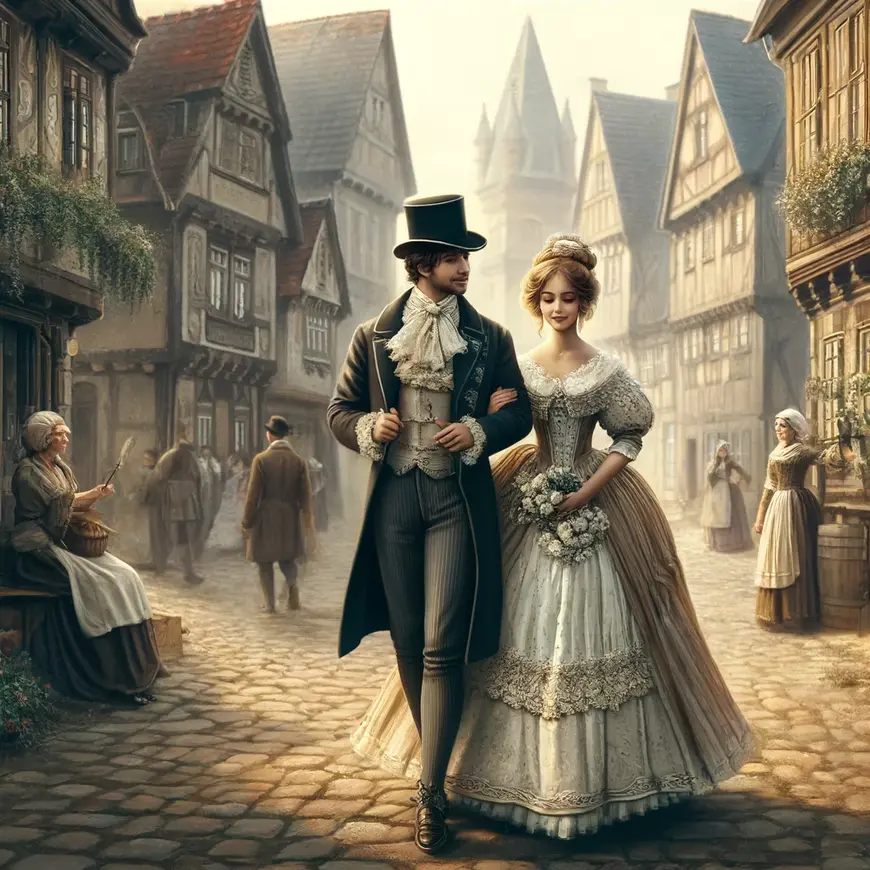A Comic Opera of Rebellion and Romance – A Review of Georg Büchner’s “Leonce and Lena”
Büchner’s Whimsical Gem – Navigating the World of “Leonce and Lena“
In the realm of theater that challenges conventions and blends humor with social commentary, Georg Büchner’s “Leonce and Lena” shines as a whimsical gem. With wit as sharp as a rapier and satire that cuts to the heart of societal norms, Büchner crafts a narrative that is both hilarious and thought-provoking. “Leonce and Lena” is a comedic opera that presents a playful rebellion against the expectations of society, love, and the pursuit of meaning in a world marked by absurdity.
Unveiling the World of Absurdity: The Setting of “Leonce and Lena”
Imagine a world where kings and queens are as clueless as court jesters, where arranged marriages are a matter of state, and where existential angst meets slapstick comedy. “Leonce and Lena” immerses us in this world, where the titular characters, Leonce and Lena, are slated to marry one another despite their complete lack of enthusiasm. Büchner’s narrative takes us on a journey through a world where the absurdity of human existence is on full display.
The setting of “Leonce and Lena” becomes more than a backdrop; it’s a stage upon which the characters’ struggles with identity, love, and societal expectations are acted out. Büchner’s prose paints a vivid picture of a society that is both farcical and uncomfortably familiar, creating an atmosphere that is both riotous and introspective.

Characters in the Spotlight: A Symphony of Absurdity and Romance
The heart of “Leonce and Lena” lies within its characters, each representing a facet of the human experience and the absurdity of societal norms. Leonce, the young prince who rebels against his arranged marriage, becomes a vessel for readers to explore themes of autonomy, love, and existential questioning. His journey from apathy to rebellion mirrors the broader human capacity to defy societal expectations.
Other characters, such as Lena, the princess resigned to her fate, and the bumbling King Peter, provide contrasting perspectives on themes of love, duty, and the absurdity of authority. Büchner’s portrayal of these characters serves as a mirror to the absurdity of human existence and the ways in which individuals navigate the often-ridiculous demands of society.
Themes of Rebellion and Absurdity: Insights Explored
“Unraveling the tapestry of rebellion and absurdity,” Büchner seems to say, as he delves into themes that resonate deeply with the human experience. The theme of rebellion is central to the narrative, as Leonce and Lena both rebel against the expectations placed upon them. Büchner’s exploration of rebellion prompts readers to reflect on the ways in which individuals challenge societal norms and assert their own autonomy.
Absurdity is another prominent theme that surfaces throughout the narrative. Büchner’s portrayal of a world in which the absurdity of human existence is both comical and profound serves as a testament to the often-ridiculous nature of societal conventions and authority. The tension between the pursuit of individuality and the absurdity of conformity creates a narrative that is both riotous and thought-provoking.
Prose as a Comedy of Errors: Büchner’s Writing Style
Georg Büchner’s writing style in “Leonce and Lena” is a comedy of errors, a blend of witty dialogue and farcical situations that capture the absurdity of human existence and societal expectations. His language is both sharp and humorous, creating an atmosphere that immerses readers in a world where the ridiculous and the profound coexist. Büchner’s prose carries a weight that conveys the depth of societal satire and the hilarity of human folly.
The play’s structure is deliberate, with each act presenting a new set of absurd circumstances and humorous encounters. Büchner’s writing style is a reflection of the absurdity of the world he presents, where the boundaries between reason and nonsense blur, creating a narrative that is both entertaining and thought-provoking.

Famous Quotes from “Leonce and Lena” by Georg Büchner
- “What a beautiful night! Everything is so still, as if the world were holding its breath.”
- Explanation: This quote reflects the tranquil and introspective moments that characters experience, highlighting the beauty and stillness of nature as a contrast to their inner turmoil.
- “We are all puppets, our strings are pulled by unknown forces.”
- Explanation: This line captures the theme of fate versus free will in the play. It suggests that the characters feel controlled by external forces, unable to break free from their predetermined paths.
- “The world is a madhouse, and I am one of its inmates.”
- Explanation: Leonce’s existential reflection on the absurdity of life and his role within it. This quote encapsulates the play’s satirical critique of societal norms and conventions.
- “How happy are those who have nothing to do with the affairs of the world!”
- Explanation: This quote reflects the desire to escape from the burdens and responsibilities of society. It expresses a longing for a simpler, more carefree existence.
- “I would rather be a beggar and single than a queen and married.”
- Explanation: Lena’s declaration of independence and her disdain for the constraints of royal duty and arranged marriage. This quote highlights her desire for personal freedom over societal expectations.
- “To be idle is to be free.”
- Explanation: Leonce’s assertion emphasizes the play’s exploration of idleness as a form of resistance against societal norms. It suggests that true freedom is found in leisure and the rejection of imposed duties.
- “The heart is a treasure chest, and whoever opens it loses its wealth.”
- Explanation: This metaphor reflects the idea that exposing one’s true feelings can lead to vulnerability and loss. It underscores the themes of love, trust, and the risks associated with emotional openness.
- “Love is like the wind, we cannot see it, but we can feel it.”
- Explanation: This poetic expression captures the intangible yet powerful nature of love. It conveys the idea that love’s presence is felt deeply, even if it cannot be physically seen.
Trivia Facts about “Leonce and Lena”
- Written for a Competition: “Leonce and Lena” was written in 1836 for a comedy competition organized by the publisher Cotta. However, Büchner missed the submission deadline, and the play was not entered.
- Unfinished Business: Although “Leonce and Lena” was completed, Büchner did not revise it before his death. Some scholars believe the play might have been further developed or polished had Büchner lived longer.
- First Performance: The play was first performed posthumously in 1895, nearly 60 years after Büchner’s death. It has since become one of his most well-known works.
- Political Satire: “Leonce and Lena” is a satirical comedy that critiques the rigid structures and absurdities of autocratic rule and arranged marriages, reflecting Büchner’s political views.
- Romantic Comedy: Despite its political undertones, the play is a romantic comedy that centers on the love story between Prince Leonce of Popo and Princess Lena of Pipi.
- Influence of Shakespeare: The play shows the influence of Shakespearean comedy, particularly in its use of mistaken identities, clever wordplay, and the theme of lovers overcoming obstacles.
- Existential Themes: Büchner incorporates existential themes into the play, such as the search for meaning and the struggle against societal constraints, which were ahead of his time.
- Symbolism of Idleness: The play explores the concept of idleness as a form of resistance against societal expectations, suggesting that true freedom can be found in leisure and personal choice.
- Autobiographical Elements: Some elements of the play reflect Büchner’s own life and experiences, including his disillusionment with societal norms and his engagement with political activism.
- Modern Interpretations: “Leonce and Lena” has been adapted and interpreted in various ways over the years, with modern productions often emphasizing its absurdist and existential elements.
- Büchner’s Legacy: Although Büchner died young at the age of 23, his works, including “Leonce and Lena,” have left a lasting impact on German literature and theater, influencing later writers and dramatists.
- Literary Style: The play is known for its witty dialogue, clever use of irony, and satirical portrayal of aristocratic life, showcasing Büchner’s talent for blending humor with sharp social critique.
Timeless Relevance: Today’s Reflections
While “Leonce and Lena” is rooted in its specific context, its exploration of rebellion, absurdity, and the pursuit of autonomy remains relevant in the modern world. In an era marked by discussions of individuality, societal norms, and the pursuit of meaning in an often-absurd world, Büchner’s examination of these themes offers a timeless perspective.
The theme of rebellion and its connection to individual autonomy continues to resonate, as individuals grapple with questions of identity, freedom, and the pressure to conform to societal expectations. Büchner’s portrayal of Leonce and Lena’s rebellion serves as a reminder of the enduring human capacity to defy convention and assert one’s own path in life.
Final Thoughts on “Leonce and Lena”: A Comic Opera of Existence
“Leonce and Lena” is a comic opera that invites readers to revel in the absurdity of existence, to laugh at the ridiculous demands of society, and to reflect on the nature of rebellion and autonomy. Georg Büchner’s narrative is a hilarious exploration of the human spirit, where the pursuit of love and meaning is both comical and profound.
As readers journey through the world of “Leonce and Lena,” they are reminded of the power of literature to challenge societal norms, to expose the absurdity of human existence, and to prompt us to reflect on the often-ridiculous demands placed upon us by society. Büchner’s prose becomes a mirror through which readers can contemplate their own struggles for autonomy and the absurdity of the world in which they live. “Leonce and Lena” is a testament to the enduring relevance of questions that have fascinated thinkers and artists for centuries, and it invites us to revel in the comedy of existence.
More Reviews of Works by Georg Büchner
“Danton’s Death” by Georg Büchner: A Gripping Tale of Revolution, Betrayal, and Tragedy My quick Summary on Danton’s Death by…
Unraveling Madness: Georg Büchner’s “Lenz” — A Riveting Descent into the Abyss of the Human Psyche Georg Büchner’s “Lenz” stands…
Madness and Society: A Review of “Woyzeck” by Georg Büchner In Georg Büchner’s evocative play “Woyzeck,” a harrowing tale unfolds,…


